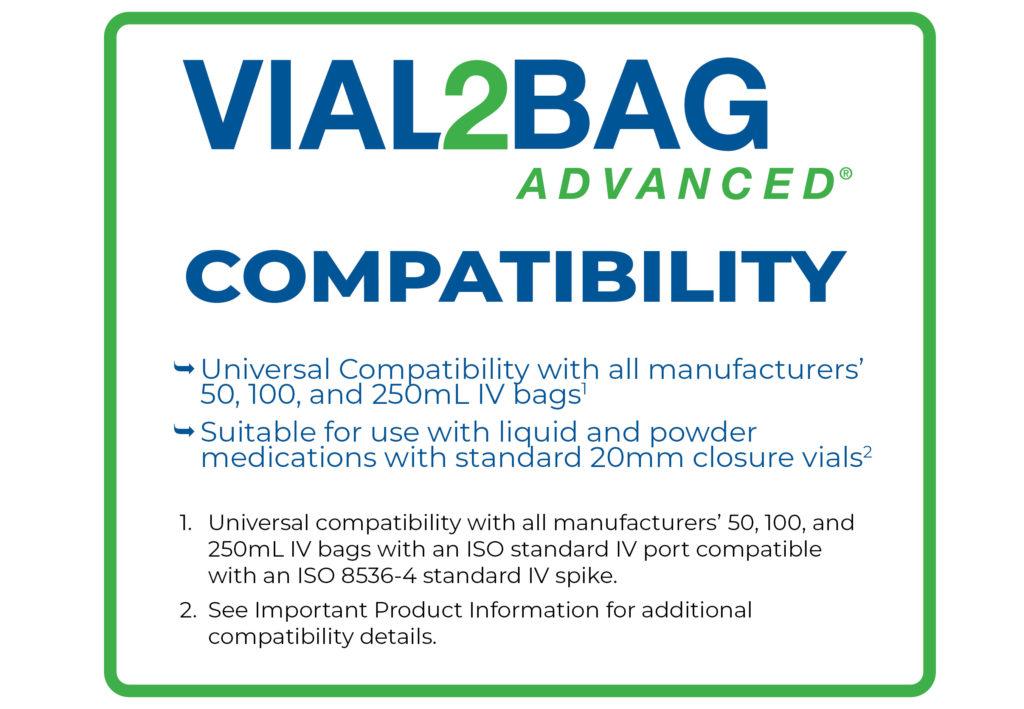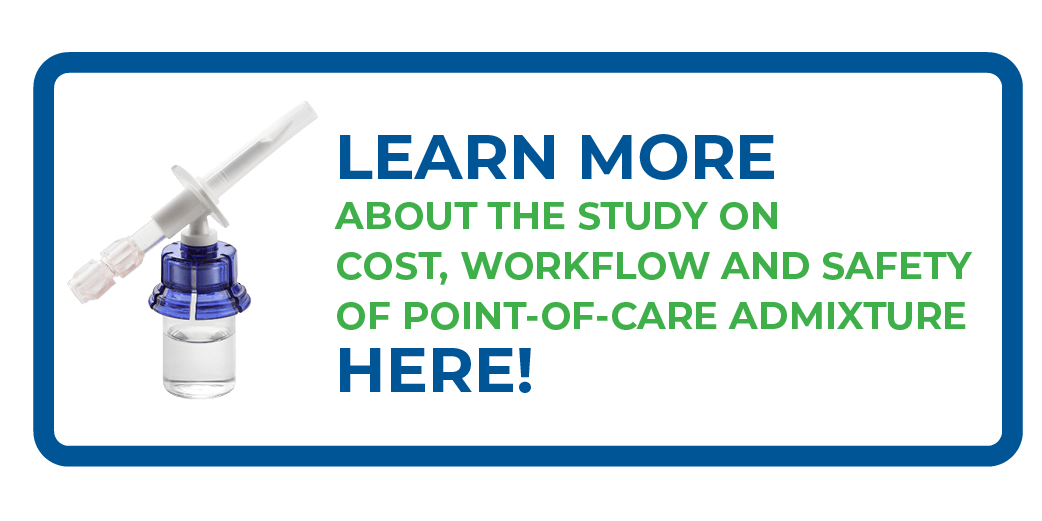Point-of-care Admixture and IV Fluid Shortage Flexibility
Shortages and supply disruptions of essential intravenous (IV) drug infusion supplies continue to afflict pharmacies across the United States. Over the last year, all IV solution producers: Baxter, B. Braun, Fresenius Kabi, Grifols Laboratories, and ICU Medical, have had an extensive array of IV bags on allocation. 1,2 IV solution disruptions remain prevalent with resupply dates for some fluids not expected until 2023. The aftershocks of COVID-related (or COVID-revealed) production challenges, looming workforce deficiencies, and increased demand related to shortages of other infusion products explain only part of the issue. IV fluid bag supply disruptions have become a constant reality in the past five years, dating back to the 2017-2018 IV fluid shortages resulting from Hurricane Maria. A single severe influenza season, a natural disaster, or even seasonal increases in hospital admissions alone can cause IV drug supply turbulence felt across the country.
explain only part of the issue. IV fluid bag supply disruptions have become a constant reality in the past five years, dating back to the 2017-2018 IV fluid shortages resulting from Hurricane Maria. A single severe influenza season, a natural disaster, or even seasonal increases in hospital admissions alone can cause IV drug supply turbulence felt across the country.
American Society of Health-System Pharmacists and the University of Utah Health released guidance for management and conservation in the face of IV fluid shortages to review the status of acute IV fluid shortages and to provide advice on strategies to manage the crisis.3 The recommendations outline fluid conservation strategies and direct clinicians to review supplies of small-volume IV bags, as well as drug vials to determine compatibility with point-of-care admixture devices. The Vial2Bag Advanced® admixture device has universal compatibility with all manufacturers’ 50, 100, and 250mL IV fluid bags*, plus liquid and powder drugs with 20mm vial closures**, providing a consistent, universal point-of-care admixture solution. The Vial2Bag Advanced® admixture device’s compatibility with any brand IV bag may help establish flexibility and IV infusion practice stability even with pervasive IV infusion supply shortages.
Point-of-care admix practices were evaluated in a 2019 Journal of Pharmacy Practice study reviewing the cost, workflow, and safety of implementing a Vial2Bag® admixture device (a precursor to the Vial2Bag Advanced® admixture device) compared to local pharmacy compounding and purchase of ready-to-use (RTU) infusions. 4,*** By using the universal device on 12 medications, the large tertiary academic medical center in Boston reported an extrapolated yearly cost avoidance of $2,295,261 and 41,082 yearly sterile product room units avoided. Admixing by nursing at the point-of-care can potentially reduce the time to first-dose for critical medications and may further optimize automated dispensing systems (ADS). The use of ADS has been shown to reduce medication errors associated with preparation and administration timing. 5 Preparing medications as close to the time of administration as possible replaces wasteful and restrictive Beyond-Use-Dating (BUD) required with advanced pharmacy compounding. ****
Point-of-care admixture practices may reduce pharmacy costs and optimize pharmacy workflow.4 As facilities continue to struggle with staffing patient-care areas, they are simultaneously dedicating more time and resources to managing shortages, updating order sets, retooling dispensing cabinets or pharmacy labeling systems, collaborating with providers on shortage action plans, and educating staff on the constant changes. The universality* of the Vial2Bag Advanced® admixture device provides an alternative to these reactive management strategies, replacing them with an adaptable and consistent point-of-care admix solution that minimizes pharmacy and nurse workflow disruptions.
Interested in reviewing the cost calculation for your facility? Contact us today for a free customized point-of-care analysis!
Important Product Information
*The Vial2Bag Advanced® 20mm admixture device is indicated to serve as a connection between a 50, 100, or 250mL IV bag with an ISO standard IV port compatible with an ISO 8536-4 standard IV spike.
**The Vial2Bag Advanced® 20mm admixture device is 510(k) cleared by the United States Food and Drug Administration (FDA). The use of the Vial2Bag Advanced® 20mm admixture device should not be interpreted as modifying, extending, or superseding a drug manufacturer’s labeling recommendations for storage and expiration dating, unless otherwise limited by USP <797> compounding standards. Refer to drug manufacturer’s labeling and use instructions for recommendations, USP <797>, and applicable institution policy for shelf life and sterility information of reconstituted product and admixture device compatibility. The Vial2Bag Advanced® 20mm admixture device is not compatible for use with all drug products. Do not use the Vial2Bag Advanced® 20mm admixture device with lipids. Failure to follow the instructions provided may result in inadequate medication reconstitution, dilution, and/or transfer, possibly leading to overdose or underdose and/or delay in therapy. Products shown are for INFORMATION purposes only and may not be approved for marketing in specific regions.
***Vial2Bag® admixture device and Vial2Bag Advanced® admixture device are separate products; West’s Vial2Bag Advanced® admixture device replaced the Vial2Bag® admixture device in commerce.
****Beyond-use dating (BUD) requirements may not apply if drug vial remains unpunctured. Always consult USP <797> and facility policy for applicable BUD requirements.
Prescription use only.
West and the diamond logo are registered trademarks of West Pharmaceutical Services, Inc. in the United States and other jurisdictions. Vial2Bag Advanced® and logo and Blue Vial Adapter are registered trademarks of West Pharma. Services IL, Ltd., a subsidiary of West Pharmaceutical Services, Inc.
References:
1. American Society of Health-System Pharmacists. Drug Shortage Resource Center, 2022. http://ashp.org/drug-shortages.
2. U.S. Food and Drug Administration. (2022, November 15) FDA Drug Shortages. https://www.acessdata.fda.gov/scripts/drugshortages/default.cfm
3. American Society of Health-System Pharmacists and University of Utah. Fluid Shortages: Suggestions for Management and Conservation, February 28, 2022. https://www.ashp.org/drug-shortages/shortage-resources/publications/fluid-shortages-suggestions-for-management-and-conservation
4. Tran LK, Anger KE, Dell’Orfano H, Rocchio MA, Szumita PM. Evaluation of Cost, Workflow, and Safety of Implementing a Vial Transfer Device for Ready-to-Mix Drugs at an Academic Medical Center. Journal of Pharmacy Practice. 2021;34(6):908-912.
5. Chapuis C, Routit M, Bal G, et al. Automated drug dispensing system reduces medication errors in an intensive care setting. Crit Care Med. 2010;28(12):2275-2281.


